|
Week 5: August 29 - September 4, 2013 |
Welcome
to the McGill Bird Observatory weekly report.
Click here for a complete listing of our archives.
Comments or
questions are welcome at "mbo AT migrationresearch.org".
|
PICTURE
OF THE WEEK: |
|
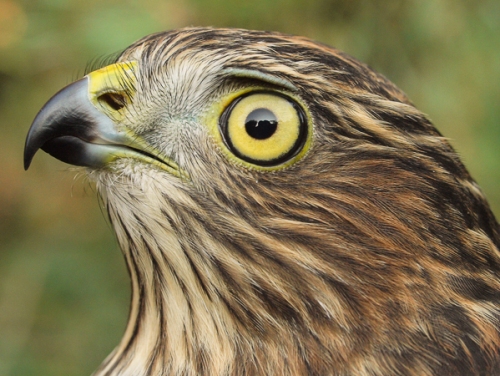
We finally banded our first Sharp-shinned Hawk of 2013 this week.
(Photo by Simon Duval)
-
|
|
|
THIS WEEK |
THIS FALL |
2013 TOTAL |
SITE TOTAL |
|
# birds (and species) banded |
309 (39) |
1269 (60) |
2564 (86) |
44076 (113) |
|
# birds (and species) repeat |
61 (15) |
319 (32) |
649 (48) |
8630 (70) |
|
# birds (and species) return |
5 (5) |
26 (15) |
181 (34) |
1390 (38) |
|
# species observed |
81 |
117 |
158 |
208 |
|
# net hours |
526.0 |
2675.5 |
6032.3 |
75322.0 |
|
# birds banded / 100 net hours |
58.7 |
47.4 |
42.5 |
58.5 |
|
|
Note: table does not include nocturnal banding (owls) |
|
Banders-in-charge: Simon Duval, Gay Gruner
Assistants: Angelika Aleksieva, Cindy Bouchard, Luke Currin, Rui de Jesus, Jo-Annie Gagnon, Nathalie Gendron, Alison Hackney, Frédéric Hareau, Lisa Keelty, Barbara MacDuff, Besty McFarlane, Catherine Russell, Marilou Skelling, Patricia Stotland, Elise Titman, Rodger Titman
IMPORTANT: MBO has been selected as one of five finalists in the Jamieson Vitamins "Call for the Wild" contest for 2013. To support MBO, all you need to do is vote daily between August 19 and September 15 by visiting the contest Facebook page (no login required). Four other organizations are competing for their share of $100,000, and the amount allocated to MBO will be entirely dependent on the number of votes received. Please help us succeed with this important fundraiser by voting for MBO every day!
Notes: Migration remained unusually strong for a second week in a row, with another 309 birds banded over the past seven days. That total was just barely behind the 311 birds banded this week in 2011 - not coincidentally the previous time that we had a big influx of Tennessee Warblers. The movement has been more sustained this year though, with the cumulative total of 1269 birds so far this fall well ahead of the previous record of 1090 set just last year. As was the case last week, numbers peaked on the second last day of the week, with 96 birds banded on September 3; the increase began the day before with 47, but otherwise the daily totals were all between 25 and 39. The diversity of species banded (39) was again well above average, but for the first time this fall the number of species observed for the week fell to below average (although just barely). Although the average number of species observed daily was 45, down only slightly from 47 the week before, the highest daily count was 49, compared to three days in week 4 with counts above 50 (as high as 58 on August 25 - the peak so far this fall). All the same, the 117 species observed to date this fall is still more than in any previous year.
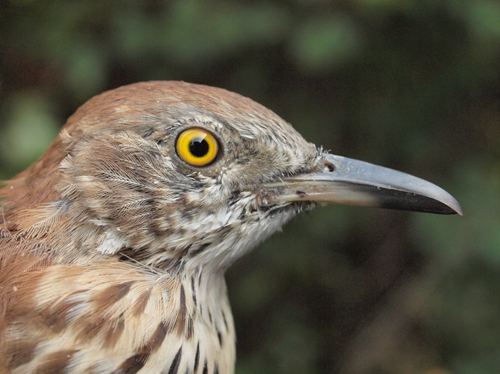
This Brown Thrasher was a return, probably a summer resident at MBO, but not captured earlier in the breeding season.
(Photo by Simon Duval)
|
With so many species observed already in the first four weeks of fall, it's not surprising that new additions are becoming scarcer. This week only Bald Eagle and Ruby-crowned Kinglet were added. However, for the first six days of the week, we added a new species daily to the list of birds banded this fall - starting with Sharp-shinned Hawk on August 29 (our first of 2013), followed by Blue-headed Vireo, Brown Thrasher, Ruby-crowned Kinglet, Eastern Wood-Pewee (our first since 2009!), and Philadelphia Vireo (also a first for this year). As well, we had four species as returns for the first time this fall, including three that were new for the year. The Brown Thrasher and Gray Catbird may be locally breeding birds, but the Nashville and Chestnut-sided Warbler returns were particularly interesting as they do not nest on site, and therefore the recapture of these birds banded at MBO in previous years is evidence of stopover site fidelity on migration.
This week’s top 10 [last week's rank in brackets]
# individuals banded |
mean # individuals observed daily |
1. Tennessee Warbler (87) [1] |
1. American Goldfinch (48) [2] |
2. Magnolia Warbler (53) [2] |
2. Cedar Waxwing (33) [1] |
3. American Redstart (24) [3] |
3. American Crow (29) [5] |
4. Common Yellowthroat (20) [3] |
4. Tennessee Warbler (25) [6] |
5. Red-eyed Vireo (13) [-] |
5. Black-capped Chickadee (16) [3] |
6. Cape May Warbler (12) [9] |
6. American Robin (12) [4] |
7. American Goldfinch (9) [8] |
7. Blue Jay (12) [7] |
8. Song Sparrow (8) [5] |
8. Magnolia Warbler (11) [10] |
9. Indigo Bunting (7) [-] |
9. Common Yellowthroat (9) [-] |
10. Ovenbird (6) [9]
10. Nashville Warbler (6) [-]
|
10. Song Sparrow (8) [7]
|
|
Remarkably little has changed since last week. Tennessee and Magnolia Warblers continued to dominate by a wide margin, with Tennessee Warbler setting another new single-week record (the number banded this week was in fact more than in six of eight previous entire fall seasons). This is the first time ever that Magnolia Warbler has not been the top species banded in week 5, even though the count of 53 individuals this week was also above average. American Redstart and Common Yellowthroat, which tied for third place last week, separated by a few individuals this week but again followed the top two species. A little influx of Red-eyed Vireos broke up the streak of warblers in the list, but was followed by Cape May Warbler - which like Tennessee Warbler set a new single-week record for a second week in a row; the total of 25 banded to date is already a new season high. American Goldfinches and Song Sparrows continue to be banded in modest numbers, and the Indigo Bunting count is gradually increasing. This week's top ten was rounded out with a couple more warbler species - Ovenbird and Nashville Warbler.
The top ten species observed this week were also relatively unchanged since last week, with only Common Yellowthroat being added, while Common Grackle dropped below the threshold. The ever-growing number of American Goldfinches finally displaced Cedar Waxwing from the top spot after a month-long reign. We have never before seen so many American Goldfinches at this time of year, but there are flocks flying overhead daily in addition to several productive families on-site; it will be interesting to see whether this translates into a spike in banding numbers at some point. Chickadees and robins were a bit less prominent this week, allowing crows to jump up to third place, while the big wave of Tennessee Warblers was enough for them to crack the top five for the first time ever. Blue Jay numbers remain steady, while Magnolia Warblers are on the increase and Song Sparrows are dropping slowly down as the season progresses (although we could well see another wave of migrants cause the numbers to increase again).
|
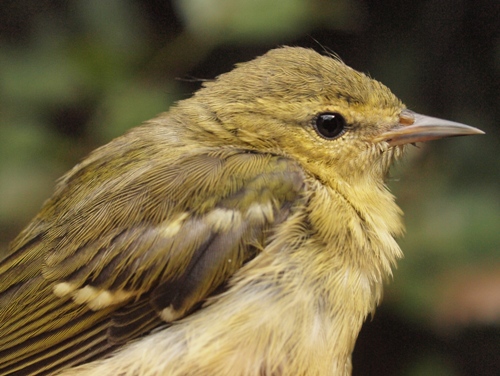
Tennessee Warblers have been dominant the past couple of weeks, but even so there are surprises, such as this one that appears to be entirely in juvenile plumage.
(Photo by Simon Duval)
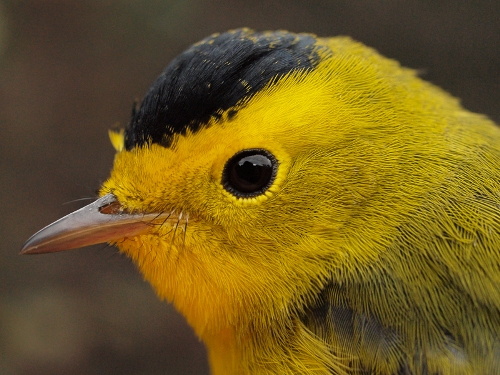
Wlson's Warbler usually peaks at MBO in the first half of September; to date only 8 individuals have been banded this fall, including the after-hatch-year male above, but the main migration is likely to come next week.
(Photo by Simon Duval)
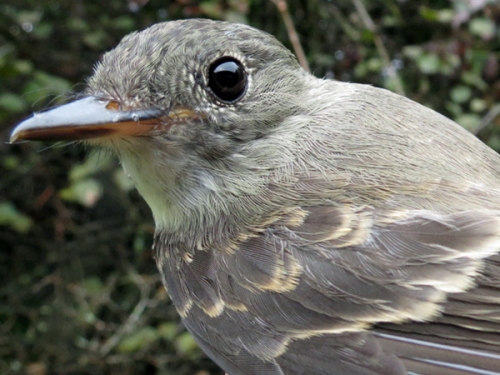
This Eastern Wood-Pewee banded this week was the first since 2009, and only the 8th overall in MBO's 9 years of operation.
(Photo by Gay Gruner)
|





